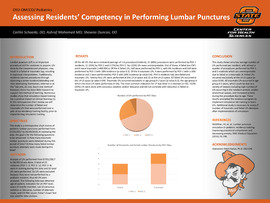| dc.contributor.author | Schaede, Caitlin | |
| dc.contributor.author | Mohamed, Ashraf | |
| dc.contributor.author | Duncan, Shawna | |
| dc.date.accessioned | 2020-05-05T19:38:00Z | |
| dc.date.available | 2020-05-05T19:38:00Z | |
| dc.date.issued | 2020-02-28 | |
| dc.identifier | ouhd_schaede_assessingresidentscompetency_2020 | |
| dc.identifier.citation | Schaede, C., Mohamed, A., & Duncan, S. (2020, Feb. 28). Assessing residents' competency in performing lumbar punctures. Poster presented at Research Day at Oklahoma State University Center for Health Sciences, Tulsa, OK. | |
| dc.identifier.uri | https://hdl.handle.net/11244/324247 | |
| dc.description.abstract | Background: Lumbar puncture (LP) is an important procedural skill for residents to acquire. LPs done by the inexperienced physician, may result in a failed or traumatic tap, resulting in equivocal interpretation. Traditionally, residents learned procedures through observing a senior resident/attending and then attempting themselves, referred to as the see one, do one, teach one method. However, there has been little research to support this method of learning. Numerous studies show that simulation-based training has a positive impact on clinical learning (1). In this retrospective chart review, we will determine the number of failed and traumatic LPs that were performed over a year at our residency training facility, prior to implementing simulation training. | |
| dc.description.abstract | Method: Analysis of LPs performed from 07/01/2017 to 06/30/18 was done. A total of 29 residents (PGY-1: 9, PGY-2: 12, PGY-3: 8) and 52 total LPs performed during this time. Six LPs were excluded because they were not performed by a pediatric resident, thus 46 LPs were analyzed. The following data was obtained: age of patient, indication for LP, PGY level, space of needle insertion, use of conscious sedation or lidocaine, number of attempts made, and CSF RBC count. Fisher's Exact Test was used for data analysis. | |
| dc.description.abstract | Results: Of the 46 LPs that were reviewed (average of 1.6 procedure/resident), 31 (68%) procedures were performed by PGY-1 residents, 11 (25%) by PGY-2 and 3 (7%) by PGY-3. Ten (22%) LPs were uninterpretable. Out of those, 4 failed (no CSF) and 6 were traumatic (>400 RBCs). Of the 4 failed LPs, half were performed by PGY-1, with 6% incidence and half were performed by PGY-2 with 18% incidence (p-value 0.5). Of the 6 traumatic LPs, 4 were performed by PGY-1 with a 16% incidence and 2 were performed by PGY-2 with 28% incidence (p-value 0.6). PGY-3 residents had zero failed and traumatic LPs. Twenty-four LPs were performed at the L3-L4 space and 22 at the L4-L5 space. All failed LPs occurred at the L4-L5 space (p-value 0.04). Traumatic LPs occurred exclusively in age group 0-2 years (p-value 0.3), the age group in which the most LPs were performed (n=36). The most common indication for LP was fever in a neonate (n=10). 15/46 (33%) LPs were done with conscious sedation and/or lidocaine and did not correlate with reduction in failed or traumatic LPs. | |
| dc.description.abstract | Conclusion: This study shows very low average number of LPs performed per resident, with almost a quarter of procedures performed by PGY 1 and 2 residents which are uninterpretable due to failed or a traumatic LP. Failed LPs occurred exclusively at the L4-L5 space (p-value 0.04). All traumatic LPs occurred in age group 0-2 years, which could be due to a variety of reasons including high number of LPs occurring in the newborn period, smaller anatomical spaces, and increased activity during the procedure due to age. These results prompted the residency program to implement simulation lab training to learn LPs. Additional study is necessary to assess if number of traumatic and failed LPs decrease after implementation of simulation. | |
| dc.format | application/pdf | |
| dc.language | en_US | |
| dc.publisher | Oklahoma State University Center for Health Services | |
| dc.rights | The author(s) retain the copyright of have the right to deposit the item giving the Oklahoma State University Library a limited, non-exclusive right to share this material in its institutional repository. Contact Digital Resources and Discovery Services at lib-dis@okstate.edu or 405-744-9161 for the permission policy on the use, reproduction or distribution of this material. | |
| dc.title | Assessing residents' competency in performing lumbar punctures | |
| osu.filename | ouhd_schaede_assessingresidentscompetency_2020.pdf | |
| dc.type.genre | Presentation | |
| dc.type.material | Text | |
| dc.subject.keywords | lumbar puncture | |
| dc.subject.keywords | pediatrics | |
| dc.subject.keywords | simulation training | |
